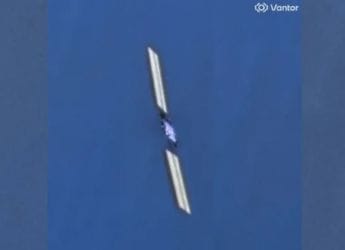- Home
- Science
- Science News
- Galaxies Galore: Here’s What Glitters In This New Image By NASA’s Hubble Space Telescope
Galaxies Galore: Here’s What Glitters In This New Image By NASA’s Hubble Space Telescope
The Hubble Space Telescope shared an image of a galaxy located about 11 million light-years away

Photo Credit: Twitter/NASAHubble
Caldwell 5 appears towards the equator of the Milky Way's pearly disc
The Hubble Space Telescope has revolutionised astronomy since its deployment in 1990. The telescope, which has a crystal-clear perspective of the universe and is far above rain clouds, light pollution, and atmospheric distortions, has taken some stunning photos of the most distant stars as well as planets in our solar system. A new image from the telescope reveals a fascinating spiral galaxy called Caldwell 5. This galaxy is approximately 11 million light-years from Earth. The image is notable for the galaxy's well-defined star arms that spread out from its yellow centre.
The galaxy's core has an active star nursery capable of producing thousands of stars in a couple of million years.
Take a look at the image here:
Caldwell 5 glitters in this new #GalaxiesGalore image!
— Hubble (@NASAHubble) May 11, 2022
This spiral galaxy lies about 11 million light-years away. At its core is an energetic star nursery that can create thousands of stars over the course of a couple million years.
Read more: https://t.co/nDUaMJF255 pic.twitter.com/KksdpBIqPv
One can witness intertwined tendrils of dust in breathtaking arms wrap around a dazzling core of hot gas and stars in this sparkling, face-on image of the galaxy's heart. This core is a sort of region known as a H II nucleus, which is an ionised area of atomic hydrogen. Thousands of stars can form in these intense birthplaces of stars over the course of a few million years. Each young, highly hot blue star generates ultraviolet light, which further ionises the gas around it, states a NASA blog post.
Caldwell 5, despite its reasonably bright 8.4 magnitude, does not stand out in the sky. It appears towards the equator of the Milky Way's pearly disc, which is obscured by thick cosmic gas, dark dust, and bright stars. As a result, astronomers must stare across light-years of space filled with visual obstructions in order to discern the complexities of the galaxy. So, Caldwell 5 is also known as the Hidden Galaxy.
Caldwell 5 would be one of the brightest galaxies in our sky if it weren't hidden by so much interstellar matter. It's a small galaxy, measuring about 50,000 light-years across and billions of years old.
William Frederick Denning, a British amateur astronomer, discovered Caldwell 5 in the early 1890s, states NASA. Located in the constellation Camelopardalis, Caldwell 5 is best seen in the Northern Hemisphere between late autumn and early winter. Only people living near the equator in the Southern Hemisphere can see it low in the northern sky during late spring or early summer.
The Hidden Galaxy, as its name suggests, can be difficult to spot, especially if the sky is light-polluted or even slightly foggy or hazy.
Get your daily dose of tech news, reviews, and insights, in under 80 characters on Gadgets 360 Turbo. Connect with fellow tech lovers on our Forum. Follow us on X, Facebook, WhatsApp, Threads and Google News for instant updates. Catch all the action on our YouTube channel.
Related Stories
- Samsung Galaxy Unpacked 2025
- ChatGPT
- Redmi Note 14 Pro+
- iPhone 16
- Apple Vision Pro
- Oneplus 12
- OnePlus Nord CE 3 Lite 5G
- iPhone 13
- Xiaomi 14 Pro
- Oppo Find N3
- Tecno Spark Go (2023)
- Realme V30
- Best Phones Under 25000
- Samsung Galaxy S24 Series
- Cryptocurrency
- iQoo 12
- Samsung Galaxy S24 Ultra
- Giottus
- Samsung Galaxy Z Flip 5
- Apple 'Scary Fast'
- Housefull 5
- GoPro Hero 12 Black Review
- Invincible Season 2
- JioGlass
- HD Ready TV
- Laptop Under 50000
- Smartwatch Under 10000
- Latest Mobile Phones
- Compare Phones
- Huawei Nova 15
- Huawei Nova 15 Pro
- Huawei Nova 15 Ultra
- OnePlus 15R
- Realme Narzo 90x 5G
- Realme Narzo 90 5G
- Vivo S50 Pro Mini
- Vivo S50
- Asus ProArt P16
- MacBook Pro 14-inch (M5, 2025)
- Huawei MatePad 11.5 (2026)
- OnePlus Pad Go 2 (5G)
- Huawei Watch 10th Anniversary Edition
- OnePlus Watch Lite
- Acerpure Nitro Z Series 100-inch QLED TV
- Samsung 43 Inch LED Ultra HD (4K) Smart TV (UA43UE81AFULXL)
- Asus ROG Ally
- Nintendo Switch Lite
- Haier 1.6 Ton 5 Star Inverter Split AC (HSU19G-MZAID5BN-INV)
- Haier 1.6 Ton 5 Star Inverter Split AC (HSU19G-MZAIM5BN-INV)

















